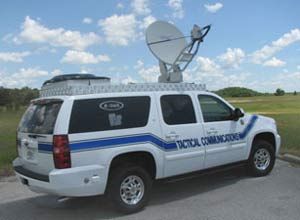By Cristi Laquer
FireRescue1 Staff
 Photo E-One |
OCALA, Fla. — Delivering high-tech radio communications and interoperability capabilities in an SUV sounds like a tough task.
But a partnership between E-One and Incident Communication Systems (ICS), a military and public safety mobile communications provider, has brought about a vehicle that does just that.
The Comms-ONE aims to combine mobility and a satellite interoperability system to help create unified command and communications at any incident location.
Built on a Chevrolet Suburban chassis, the unit was launched last year, with Charlotte, N.C., becoming the latest department to place the unit into service in August.
“This unit is unique in the fact that the vehicle was built around the communications, not the communications around the vehicle,” said Greg Hauser, telecommunication supervisor at the Charlotte Fire Department. “It’s practical. In a matter of five minutes we have communications.”
Hauser said the unit’s strengths were highlighted just two hours after it was put into service. “Our hazmat teams got called out for an incident and we were on scene with the unit before our crews even got there,” he said.
The system delivers radio communications and interoperability, broadband wired and wireless data, telephone and video conferencing capabilities utilizing VSAT broadband satellite services.
Different modules
Powered by Federal Signal’s public safety software suite, it features SmartMsg and radio interoperability modules, which enables simultaneous text and voice broadcast of alert notifications to first responders with two-way radios, push-to-talk devices, PCs, cell and satellite phones, pagers, wireless PDAs and other devices.
“Typically, an agency or a department will have specific missions they call it out for,” said Chris Boyd, vice president and communications architect at ICS. “If an apparatus goes for mutual aid, they’ll send the Comms-ONE along to keep communications flowing.”
The unit boasts functions that rival those found in larger command vehicles, providing modules that allow real-time access to local municipal and state databases and providing secondary command and control if an emergency operations center is rendered inoperable during a disaster situation.
In addition, a satellite link can deliver landline, mobile two-way radio, Wi-Fi access and video in support of incident command and communications when critical infrastructure is unavailable.
These satellite connections make it a valuable tool in the face of natural disasters or other major incidents, where it might be most needed, according to Boyd.
“The idea is that in a Hurricane Ike-type situation where there’s not much infrastructure left, the commander can initiate a mass notification,” he said. “It’s a continuity of operation tool, so if some buildings aren’t physically there, you can still have unified command.”










